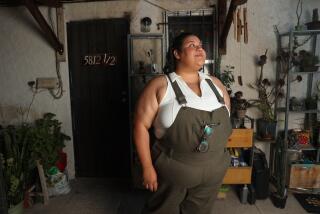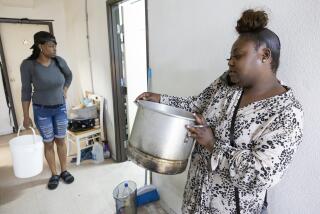Housing Sweep Has Little Effect
- Share via
THOUSAND OAKS — When officials in this wealthy enclave decided to clear out a makeshift village of immigrant families about a mile from City Hall, their reasoning was simple: People should not have to live this way.
People should not have to live in slums where garages and toolsheds serve as bedrooms. People should not live without plumbing, alongside rats and flies and flimsy electrical wires that threaten lives.
Not in Thousand Oaks. Not anywhere.
Yet three weeks after code inspectors declared the ramshackle dwellings a safety hazard during a 6 a.m. sweep--forcing many of the 50 or so inhabitants onto the street by day’s end--the people they displaced are living no better than before.
Some are sleeping in their cars or on the street, occasionally stopping by their old homes in hopes of getting a shower. Others are living in cramped, substandard housing in other parts of Thousand Oaks, places remarkably similar to the original hidden ghetto uncovered by inspectors.
“You have to pay a lot to live in this area, and we were not left with a lot of choices,” said Lazario Montana, who moved just blocks from the shantytown to another tattered house. “The work is here. That’s why we came here and that’s why we stayed.”
Concerned that Thousand Oaks’ well-meaning actions have hurt the people they were supposed to help, social activists want to make sure future code crackdowns help the displaced find better homes.
The City Council, worried that the discovery of more overcrowded ghettos will further tarnish this suburb’s squeaky-clean reputation, has already approved the creation of a tough anti-slumlord ordinance that would heap fines on property owners and speed criminal actions against them.
The next step, urges affordable housing group Many Mansions, is for Thousand Oaks to develop a comprehensive plan to assist those ousted in slum sweeps.
*
“The slumlord part is real easy to do--you put these laws in place and enforce them,” said the housing group’s director, Dan Hardy. “But the other one opens a can of worms. If we’re not going to allow slum conditions, are we going to provide housing for them? There’s got to be a solution as to where these people can live.”
Geoff Ware, the city code supervisor who headed the investigation into the rundown village, noted that inspectors passed out fliers listing telephone numbers for local charitable organizations during the sweep.
Charity workers received few requests for help, however. They suspect that many of the shantytown’s former dwellers were afraid to come forward.
“A lot of the folks admitted to being undocumented immigrants,” said Karen Ingram of Lutheran Social Services. “So there’s going to be a fear of going to any organized group.”
Ware said the presence of Ventura County sheriff’s deputies at the sweep may have given some people the impression that the investigation was a crackdown on illegal immigrants, rather than a code enforcement action. Spanish-speaking deputies acted as translators, and other deputies were there to protect inspectors in case trouble broke out, he said.
“Do we like to displace people out of what they consider their shelter? No,” Ware said. “We don’t like this appearance of putting people on the street.
“To this day, I disagree with the word ‘raid’ for what we did,” he added. “We went in there, and we were as cordial as we could be under the circumstances.”
At a meeting of charitable groups and city officials this week, Many Mansions will propose ways Thousand Oaks can assist displaced tenants, including having social workers on site during sweeps and possibly using city housing money to help people relocate.
*
Other social activists suggest that Thousand Oaks consider a similar approach to the one taken by the city of Ventura after winter floods two years ago washed out more than 100 squatters living in a large encampment on the Ventura River bottom.
Ventura’s award-winning Homeless Employment Resource Operation, or HERO program, had its share of critics. But it successfully placed more than 70 former river bottom residents in permanent housing, using federal housing vouchers obtained by the city.
“What would be helpful from the Ventura program were the financial resources that were made available,” Ingram said.
Councilman Andy Fox, who proposed the slumlord ordinance last week, believes that Thousand Oaks should assist poor people who are left homeless by city sweeps.
But he said there is a limit to what the city can do.
“I don’t think you can afford to live in Thousand Oaks for $125 a month,” Fox said. “I’m not going to put a square peg in a round hole. It’s not that I don’t care. You just can’t meet everybody’s need.”
Many residents at the shantytown were living there under a sub-rental scheme in which they were paying $100 or so to other residents to live in metal toolsheds and garages.
With that money, the sub-landlords were then paying the $800 or $950 rent for the four small houses and two wooden shacks on the property, less than one acre, to the actual landlords, Joy and Al Silver of Westlake Village.
The Silvers said they did not know the extent of the overcrowding and unsanitary living conditions on their property.
*
“The reason we were living [under that arrangement] is that rents are high and we could share the cost,” said Rosa Alvarado, 41.
Lazario Montana and his wife, Alejandra Pena, were still wandering the streets of Thousand Oaks at midnight April 17, the day the city sweep forced them out of the wooden shack where they were living.
Their lives have been a shambles ever since.
They moved into a battered one-story cottage just north of Thousand Oaks Boulevard, hidden beneath oak trees and behind an auto shop.
Because they had to be out of the shantytown by 5 p.m., they left their stereo, television, most of their clothes and many other belongings behind.
Moreover, they lost their jobs. Montana and Pena are undocumented immigrants, and they were afraid to return to the shantytown in the morning to be picked up to go to work, fearing that immigration officials had been alerted. When the couple failed to appear, the woman who paid them to clean houses fired them.
Montana now waits for work at a corner just off Thousand Oaks Boulevard, one of many day laborers hired by this city’s residents and contractors.
He said he would never have sought help from Thousand Oaks or local charities, even if he was a legal immigrant, because he and his wife have lived through plenty worse, in Mexico as well as in Thousand Oaks.
All Montana wished was to be left alone, or at least given ample warning that he had to move on.
“We did nothing for them to treat us like that,” he said. “They never gave us a reason why we couldn’t stay there a few days until we found another place to go. Why didn’t they give us two, three days warning?”
Montana and Pena stay in touch with their former shantytown neighbors through the large network of immigrants in Thousand Oaks, often meeting in local parks or at Conejo School for nightly soccer games.
*
Antonio Cruz was able to remain at the shantytown with his wife and five children, at the house where they and others shared the $950 rent. He said some people still come by, looking for a shower or a place to spend the night.
Cruz, who said he is a legal immigrant, has applied to Many Mansions for assistance and is looking for another home. The landlords demanded that he paint the house and perform some other handiwork after the city sweep, but when he asked for money or lower rent in return, they refused, he said.
Thousand Oaks, Cruz said, is not an easy place to be poor. “It’s a problem because it’s mainly rich people here,” he said. “We work hard. The gringos benefit from our work, and the least they can do is give us some consideration. They don’t care how we live.”
Chris Chi is a correspondent and Miguel Bustillo is a Times staff writer.
More to Read
Sign up for Essential California
The most important California stories and recommendations in your inbox every morning.
You may occasionally receive promotional content from the Los Angeles Times.






